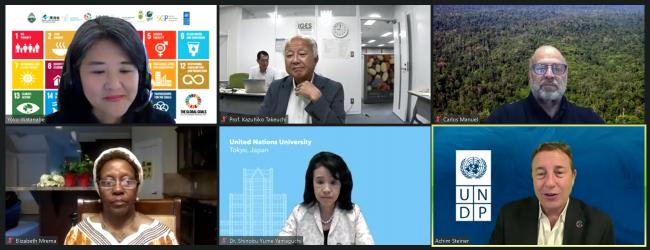Satoyama Initiative – Societies in Harmony with Nature: An inclusive approach for communities, landscapes and seascapes
Presented by the Institute for Global Environmental Strategies (IGES), Ministry of the Environment of Japan, Ministry of Environment and Energy of Costa Rica, Secretariat of the Convention on Biological Diversity (SCBD), UN Development Programme (UNDP) – Global Environment Facility Small Grants Programme (GEF SGP), and United Nations University Institute for the Advanced Study of Sustainability (UNU-IAS)
Held on the sidelines of the 2020 High-level Political Forum on Sustainable Development (HLPF), this virtual event highlighted the Satoyama Initiative. It focused on the ways in which the Initiative helps protect the planet and build resilience, advance well-being and share nature’s benefits, and foster partnerships.
The Initiative is based on the concept of “Satoyama,” a traditional rural landscape in Japan. It represents a global effort to realize societies in harmony with nature through the revitalization and sustainable management of socio-ecological production landscapes and seascapes (SEPLS) for biodiversity and human well-being. SEPLS are areas where human well-being and the ecosystems have a symbiotic relationship.
The International Partnership for the Satoyama Initiative (IPSI) was established to implement the Initiative. It was set up in 2010 during the 10th meeting of the Conference of the Parties to the CBD, held in Nagoya, Aichi Prefecture, Japan. It currently consists of 267 members, including governments, non-governmental organizations, academic institutions, and private sector entities. As its flagship program, the Community Development and Knowledge Management for the Satoyama Initiative (COMDEKS) promotes sustainable use of natural resources in the landscapes and seascapes with local communities. COMDEKS is funded by the Japan Biodiversity Fund of the SCBD, and implemented by UNDP in partnership with Ministry of Environment of Japan, CBD Secretariat, and UNU-IAS. COMDEKS has supported over total 400 community-based projects in selected landscapes and seascapes in 20 developing countries through the GEF SGP, which is implemented by UNDP.
During the event, speakers provided strategic overview and explored lessons learned through integrating the management of SEPLS into national and sub-national policies as a critical contribution to the Sustainable Development Goals (SDGs) and the post-2020 global biodiversity framework. Participants also discussed a green post-COVID-19 recovery through biodiversity conservation and sustainable use utilizing integrated landscape and seascape approaches.
Opening the event, Achim Steiner, Administrator, UNDP, emphasized the ways in which COVID-19 has revealed the connection among all living things. He also emphasized its disproportionate impact on and risk to poor and vulnerable communities. Steiner described the Satoyama Initiative as a crucial, viable pathway to expand partnerships with indigenous peoples and local communities. Sharing the ways UNDP is supporting the COVID-19 recovery, he explained that communities, science, and management of land and seascapes must find a new paradigm to make progress.
Kazuhiko Takeuchi, President, IGES, and Visiting Professor, UNU-IAS, said revitalizing the Satoyama Initiative is key to the post-COVID-19 recovery. He elaborated on the need to develop harmonious co-existence between people and nature and to localize the SDGs. He pointed out the ways in which SEPLS are used to develop environmental conservation while trying to fully utilize these resources for human well-being. Calling for continued international collaboration, Takeuchi noted the role of SEPLS as buffer zones between protected areas and denser human settlements and noted successes from around the world.
Shinjiro Koizumi, Minister of the Environment, Japan, commended the Satoyama Initiative for enhancing resilience and sustainability in communities throughout the world. He explained “local production for local consumption” reframes our relationship to where we live, as well as contributes to conservation and disaster risk reduction. He outlined ways to redesign socio-economic systems to recover from COVID-19 through decarbonization, circular economies, and decentralization. He expressed Japan’s intention to continue supporting the Satoyama Initiative so that the initiative can contribute to the implementation of the post-2020 global biodiversity framework.
Carlos Manuel Rodriguez, Minister of Environment and Energy, Costa Rica, and incoming GEF CEO, spoke to the Initiative’s core philosophical principles and redefinition of the relationship between humans and nature. He suggested developing these principles as a “vaccine” to overcome the serious health threats posed by COVID-19. He explained that the Initiative has bridged the environment and agriculture sectors in Costa Rica by supporting alignment in agendas, plans, and budgets.
Elizabeth Maruma Mrema, CBD Executive Secretary, emphasized biodiversity remains a solution to sustainable development challenges the world faces. She underlined that the COVID-19 pandemic serves as a stark reminder and called for urgent international cooperation to conserve biodiversity, build resilient and sustainable economy, and protect human health for generations to come. She recognized the value of lessons learned from the Satoyama Initiative’s community development and sustainable use of biodiversity. She expressed hope this will contribute to ongoing work towards a robust and ambitious post-2020 global biodiversity framework as well as the achievement of the Sustainable Development Goals.
Shinobu Yume Yamaguchi, Director, UNU-IAS, discussed the ways in which science and academia provide evidence to policymakers and educate younger generations. She highlighted the role of local stakeholders in developing and implementing toolkits for assessing community resilience. She said further international collaboration will promote the scaling up of activities, increasing regional and global impact, highlighting UNU-IAS’s work hosting the secretariat of the IPSI for this purpose.
During ensuing discussions, participants:
- explored ways to reconcile demand for large-scale industrial production with low-impact agricultural techniques;
- identified the value of digital technology to increase transparency in supply chains; and
- emphasized the need for global collaboration to achieve sustainable progress, including formal political spaces for civil society and the private sector.
In conclusion, Moderator Yoko Watanabe, Global Manager, GEF SGP, thanked panelists and the over 260 participants who attended the event.
This event was held on 16 July 2020 in a virtual format due to the COVID-19 pandemic.
Contact
Ana Maria Currea | ana.maria.currea@undp.org
